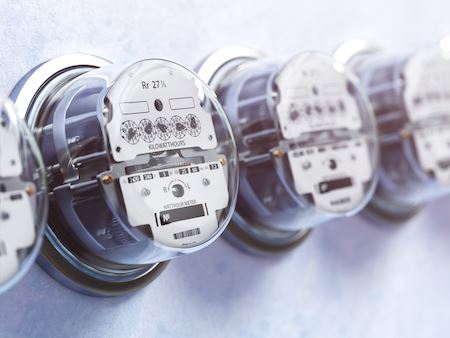Have you ever had a jump in your utility bill and wondered why? Do you know how to read your residential electric and gas meters? It can help you determine how efficient you are with your energy usage. It can also alert you to discrepancies between what you’re charged and what you actually used.
First, locate your utility meter. They are most often attached somewhere on the outside of your house.
How to read an electric meter
Electrical power is measured by watts. One thousand watts are called a kilowatt. Your utility company will bill you by the amount of kilowatts you use, listed as kWh.
Depending on the age of your home determines what type of electrical meter you’ll have installed. The standard electric meter resembles a clock with wheels that spin as electricity moves through it. As a home draws in electricity, the wheels turn to record how much it uses. The number of revolutions can be registered if you look at the dials.
With newer homes, electric meters are advancing in technology. You might find your meter is digital or smart technology. Nearly half of all US electricity customers use smart electric meters to monitor their use.
To read an electric meter, write down the numbers on the dials from right to left. Use the pointer as your guide and write down the number to the right. If it hasn’t passed zero, use the lower number. If it has, use the next higher number. If it falls between two numbers, use the lower of the two.
How to read a gas meter
Natural gas is measured by the cubic foot. Your bill will show your use in hundreds of cubic feet (CCF) or thousands of cubic feet (MCF).
Your gas meter is installed at the point of distribution into your home, between the electric power and gas lines. Like an electric meter, the gas line is powered as natural gas enters your home. The more you draw into your home, the faster the dial moves.
To calculate use, record the numbers on the dials. Gas meters work opposite from electric meters. You’ll write down the numbers from left to right. The dials on each will rotate in different directions.
Likewise, gas meters are also being updated. You might have digital meters instead of more traditional ones.
Estimating your cost
The numbers on your meters will never reset to zero. Therefore all calculations are continuous from one month to the next. If you pull up your last utility bill, you’ll find the numbers listed somewhere on the bill. Using your new reading, you can calculate your kWh or CCF use. This should be a close estimate of what your current usage is. You can use this to ensure you’re billed at the correct rate.
If you notice a discrepancy, you can contact your local utility company for verification. If you believe you have a problem with your electric or natural gas systems, we’re here to help.

